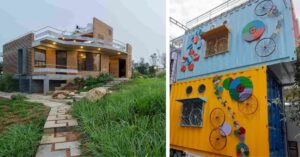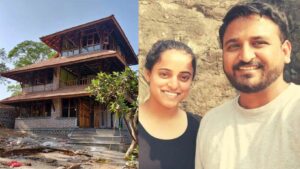Delhi Firm Uses Ancient Practices To Make Modern Buildings Cool & Eco-Friendly
Over the past 18 years, Studio Lotus has prevented thousands of tonnes of carbon emissions with their eco-conscious strategies.

Last September, Krushi Bhavan in Bhubaneswar, Odisha grabbed headlines across the world for its state-of-the-art architectural finesse after it was shortlisted for the prestigious World Architecture Festival (WAF) Award 2019. The architecture of the sprawling campus was heavily inspired by the distinctive ikat weave of Odisha in a way that is also climate-responsive.
More than a hundred skilled artisans worked with regional materials and replicated the vibrant and traditional vernacular narratives on the building structure. For instance, the material palette uses a combination of exposed brick and local stones like laterite and khondalite.
Agricultural folklore and local mythologies are meticulously depicted through handcrafted furniture, stone carvings and metal installations in the interiors. For example, ripe paddy crops are beautifully weaved through the technique of the bas-relief carvings in laterite and are illustrated through the Odia Pattachitra (cloth-based scroll paintings) style.
Another striking example is its distinctive brick facade made using three different colour clays. It acts as a solar shading device. Other sustainable parameters include the courtyard that allows optimal air ventilation and deeply recessed windows and balconies that restrict the heat from penetrating inside.
A night-purging system was devised that captures the cool air in the night and distributes it across the building during the day — which is why it’s not a surprise to find out that only 20 per cent of the campus has an air conditioning unit.
“Through this mechanism, cool air gets pulled into the building through the northern façade when temperatures drop at night, by means of a custom-designed ‘low-tech’ damper system. The high thermal mass of the building traps the ‘coolth’ and becomes a ‘coolth’ exchanger with the surrounding air in the day when outside temperatures are higher,” Sidhartha Talwar, co-founder of Studio Lotus tells The Better India.
The building also has solar panels on the terrace, on-site rainwater harvesting and wastewater treatment, and anaerobic composting unit.
Krushi Bhavan is one of those rare buildings in India that intricately captures the local traditions and celebrates the dying art of artisans while being environmentally-conscious.
Krushi Bhavan was constructed by Delhi-based Studio Lotus, an architecture firm founded by Sidhartha , Ambrish Arora and Ankur Choksi in 2002.
What makes the sustainable practices of this firm stand out is its ability to draw inspiration from the local culture while relying on contemporary technology and climatologically responsive designs.
The integration of jaalis, for example, is another effective way and a safe bet in curbing solar glare and allowing the breeze inside through its perforated skins.
“The use of jaalis for us has been of considerable significance, considering its function as not just an effective means of climate control, but also its historical significance as a memory marker, evocative of an Indian way of life. It creates interesting interplays of light and shadow,” adds Sidhartha.
RAAS Jodhpur, a luxury boutique hotel situated in the city’s Mehrangarh Fort is a mention-worthy testimony to this. Taking a leaf out of ancient practices, the firm developed a double-skinned structure, the buildings have an outer skin of jaali work (stone latticework) and inner skin of masonry and glass.
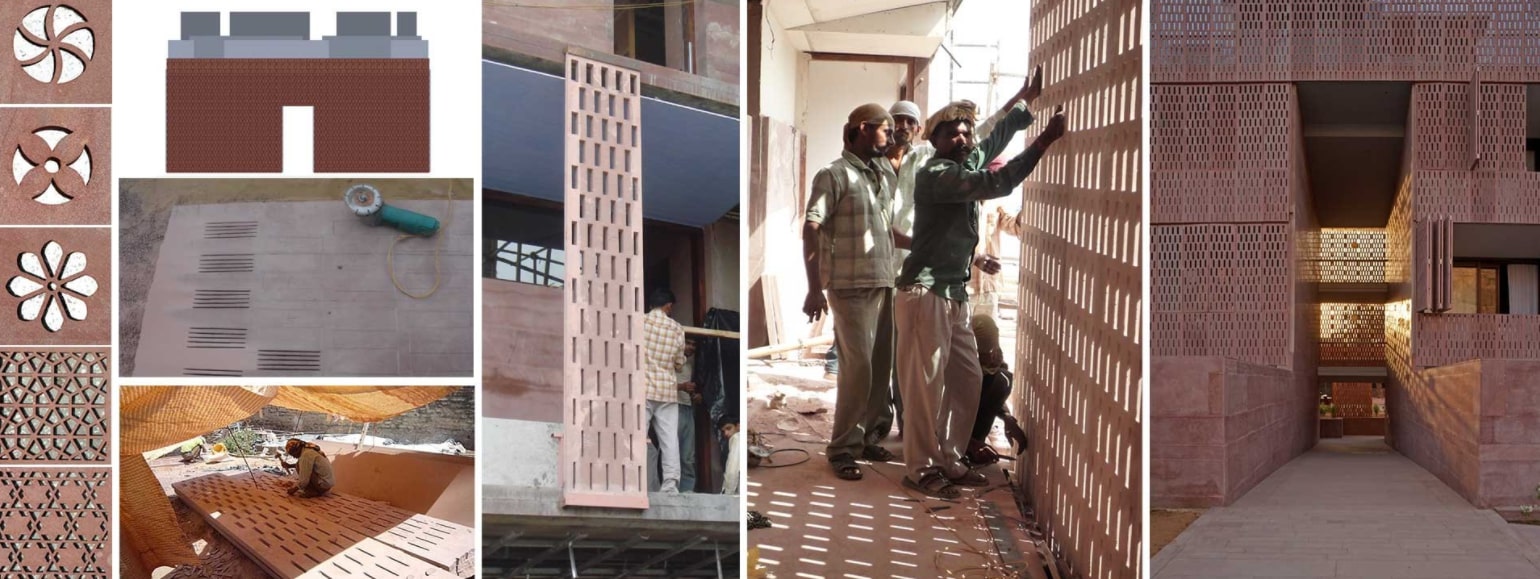
The jaali, constructed with local Jodhpur sandstone, helps in passive cooling and ventilation while maintaining privacy. The jaalis are constructed in a way that guests can fold them to view the nearby magnanimous forts. Other methods include lightwells and skylights for poorly-lit interior spaces, low window-wall ratios, masonry with higher thermal mass. Water bodies and thermal buffers in the form of vegetation also play a crucial role to cool down temperatures.
These solid principles are not limited to the Krushi Bhawan and RAAS Jodhpur; they can be seen in practically every project that the Aga Khan Award-nominated architecture firm has completed. In the last 18-odd years, they have prevented thousands of tonnes of carbon emissions with their eco-conscious material palette and passive cooling strategies.
Today, the company has its fingers in a lot of pies as their projects boast of independent bungalows, community houses, government offices, corporate houses, restaurants, hotels and so on. The team has also seen exponential growth in its staff with a strength of sixty and five Principals, Ambrish, Sidhartha, Ankur, Asha Sairam and Pankhuri.
Their phenomenal and responsible work has bagged several accolades, recognitions and awards at both, domestic and international platforms. Some of them include World Holiday Building of the Year (2011) at World Architecture Festival Barcelona.
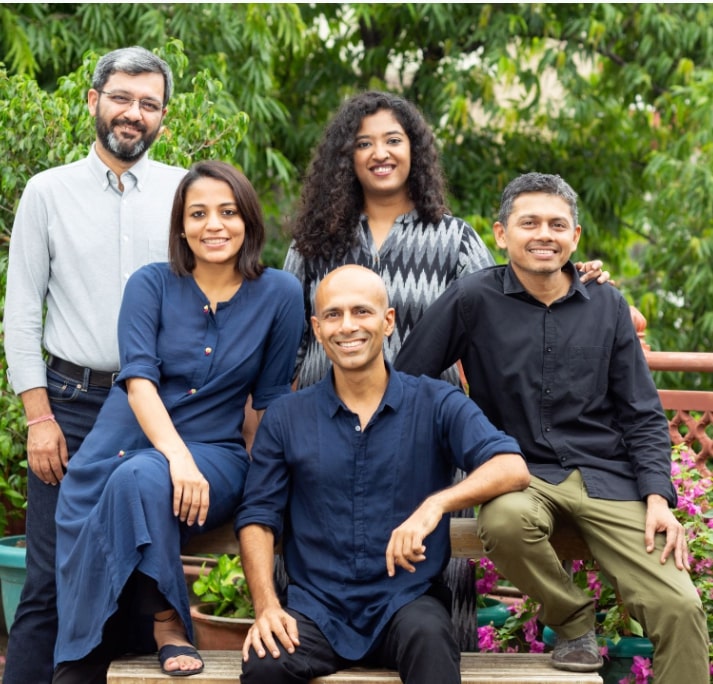
An Insight Into The Material Palette of Studio Lotus
Sidhartha believes that there is very little attention and care given to build a circular economy of construction materials. However, there are two ways in which this can be corrected — by raising awareness and creating less-harmful options.
“There needs to be a lot more data on carbon footprints of different materials and the true cost of a new building (which is the cost to the planet) versus studies on costs of adapting existing buildings. This will hopefully move the focus away from bringing down what are often sound structures to build new ones, with a more aggressive approach to the adaptation of existing buildings, which have several decades of life still in them,” he says.
One can use technology to innovate feasible alternatives. He gives an example of construction blocks that are made from recycled construction debris.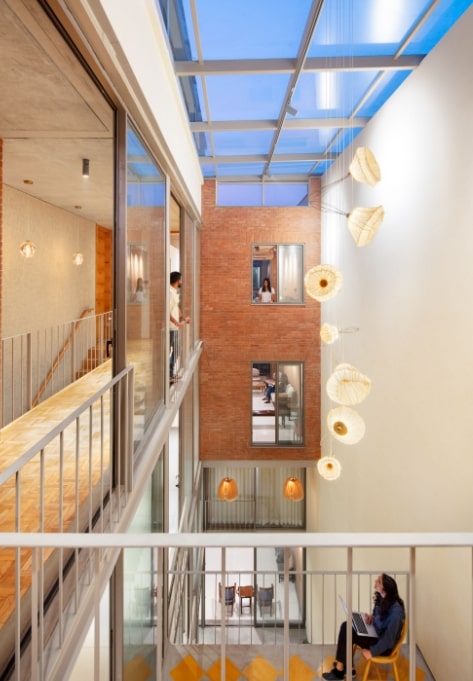
Take, for instance, the Stacked House in Delhi. The architecture firm worked with BL Manjunath, a structural engineer, to develop a hybrid structural system, consisting of a modular metal grid of beams and columns that maximises heights and creates seamless sightlines. It has an earthy material palette that supports open and airy spaces.
Coming to the architecture firm’s material palette, the fundamental goal is to optimise daylight and ventilation, especially for residential projects.
Delhi’s ‘House with A Brick Veil,’ is yet another fine example of building a passive cooling building.
The challenge here was to connect with nature in a congested residential area that has an unpleasant view with scattered trees and traffic jams. The building, with a stack of 3 apartments, is a brick masonry structure that has a high thermal mass maximising daylight and minimising solar gain. 
The 345-mm thick “brick veil” around the building acts as a buffer between the home and the otherwise noisy street city. The open volume in the interiors is split into two and placed at the opposite ends of the house to create ventilation and light.
“Despite being in a densely packed neighbourhood, the courtyard brings in ample light into each room. The house remains well ventilated and cool throughout the year. Through the lockdown, I don’t know how many times we have been truly grateful to be in this beautiful space. Not being able to step out of the gate for almost six weeks was made so much more pleasurable because of all the wonderful spaces, light and views,” says Darpan Wadhwa, a resident of Stacked House.
An Architecture Firm That Chooses Authenticity Over Luxury
With rapid industrialisation and globalisation, India has seen a massive influx of foreign construction materials at expensive rates. Imports also significantly increase carbon footprints and further disbalances the ecology.
Instead of opting for a luxury lifestyle at the cost of nature, it is necessary to stick to the traditional roots through the authenticity of material usage.
“We encourage minimizing consumption and empowering all stakeholders. The frequent use of reclaimed materials and architectural elements, creation of seamless indoor-outdoor connections, optimization of daylight ingress, ventilation and cooling, as well as the strategic integration of craft as a functional and artistic expression is according to us, both suitable and necessary and becomes an intrinsic part of going back to the basics,” Sidhartha emphasises.
When asked if this will affect the cost range, he firmly says that one must think about the long term costs and whether one is calculating the losses due to environmental degradation.
“While it’s true that initially, these systems can be expensive to work with; however, the operational costs over the building’s life-cycle result in significant financial and environmental savings,” he says.
For the architecture firm, combining sustainable practices, artistic skill and cultural landscape to provide distinct identities to buildings was not an overnight activity.
It took the firm nearly four years to understand the dire need to preserve our traditional construction styles and actively consolidate them into their practices.
“When we started, one of the most important lessons we learned was that the project concept is only as good as its execution at site. People — teams and artisans — were key-enablers. This people-centric approach, where the architect becomes a facilitator — as opposed to the author — in the creation of the building, was a marked deviation from our earlier preoccupation with concept-driven projects and has served as the bedrock of the practice ever since. The building is only as good as the sum of the parts that come together to create it,” Sidhartha says.
Edited by Gayatri Mishra
This story made me
- 97
- 121
- 89
- 167
Tell Us More
We bring stories straight from the heart of India, to inspire millions and create a wave of impact. Our positive movement is growing bigger everyday, and we would love for you to join it.
Please contribute whatever you can, every little penny helps our team in bringing you more stories that support dreams and spread hope.






